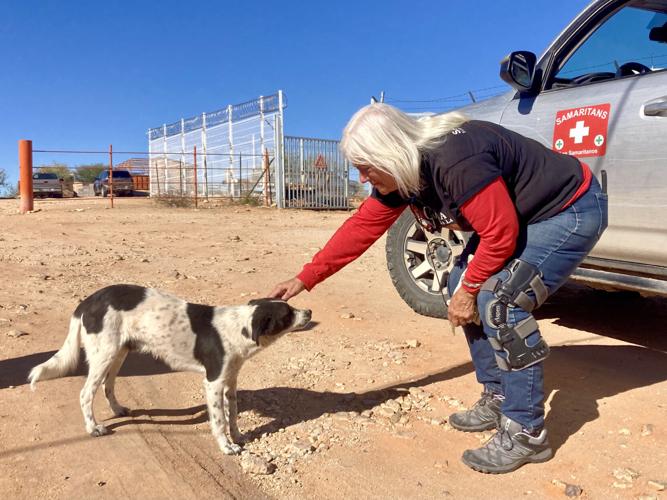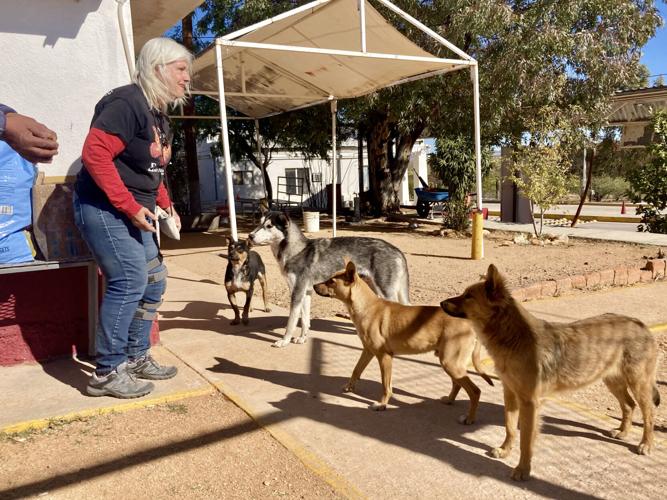SÁSABE, Sonora — Residents of the besieged Mexican town of Sásabe say they feel abandoned by the government and are looking to one another for support, as they wait for a violent conflict between criminal factions to resolve.
Even as thousands have fled the intense gun battles in the border town, about 100 residents remain. One-third of them are children, two longtime residents told the Arizona Daily Star on Wednesday.
The Mexican National Guard has imposed a curfew of 5 p.m. amid the ongoing conflict between factions of the Sinaloa Cartel, battling for control of lucrative human-smuggling routes in the region.
The two residents — who spoke to the Arizona Daily Star close to the port of entry connecting the border town to Sásabe, Arizona — asked that their names not be published, as their lives could be put at risk by speaking publicly.
The schools in Sásabe, Sonora have closed their doors, but children continue to take classes online, using systems set up during the pandemic, said one resident, who is a father.
Residents of Sásabe aren’t involved with the criminal groups that have taken over, “but we are the ones who suffer the consequences,” said one woman who has lived in Sásabe, Sonora for 40 years. She’s hoping to wait out the violence.
“We have to resist,” she said. “Our house is the only thing we have.”
The residents, speaking in Spanish, told the Star that those who remain in Sásabe all know each other and many check in by phone daily, reporting whether they’ve heard gunfire and making sure their neighbors are all right.
In October, hundreds began fleeing Sásabe, Sonora, which previously had a population of about 2,500. Some crossed into Arizona through a gap in the border wall, while others were able to secure humanitarian parole. For many, fleeing to the south was not an option, as criminal groups were stopping cars headed south toward Altar and violently interrogating passengers, former residents told the Star.
Across northwest Sonora, violence has prompted the closure of at least 26 schools, including in Sásabe, Oquitoa, Átil, Tubutama and Sáric, according to Caborca-based news outlet Contenido 360.
Reporters focused on cartel activity, including Borderland Beat, say the current battle is between the criminal group that used to control the Altar region, known as the Cazadores — the Hunters — and the groups known as Los Deltas and Los Pelones, who have taken control of the area between Altar and Sonoyta, said Natalia Mendoza. She is an anthropologist and co-founder of the nonprofit Altar Desert Research Center, which documents violence, ecological damage and the overall impact of border militarization.
The latter groups “are now one single, incorporated mafia and they have the support of Los Chapitos, the sons of ‘El Chapo’ Guzman, and they’re trying to eradicate what used to be the cartel from Altar,” Mendoza said.
The violence in northwest Sonora appears to be contributing to detours in established human smuggling routes, sending migrants further west, toward Lukeville, Arizona, Mendoza said.
The presence of more authorities in northern Sonora has meant some of the brechas — rough dirt roads — stretching north from Altar have been out of use, she said.
“The brecha to Sásabe, which used to be the main corridor, is now empty,” Mendoza said. “Because of law enforcement they have been using other routes that are a little bit westwards of Altar, so more towards Sonoyta (Sonora), towards Lukeville (Arizona).”
Little government presence
Residents still in Sásabe, Sonora say that Mexican National Guard soldiers have not intervened in gun battles that shook the town.
Before the National Guard arrived, residents were left completely alone for a week amid active gunfights, with some barricading themselves in their homes, said Dora Rodriguez, chairwoman of Humane Borders in Tucson and co-founder of Salvavision. The nonprofit runs a migrant-resource center in Sásabe, Sonora that has shut its doors in light of the violence.
“Locals were begging authorities to come and help,” said Rodriguez, who has helped a number of Sásabe residents escape by securing temporary humanitarian parole in the U.S.
It’s been quieter in recent days, with gunfire largely contained to the outskirts of Sásabe, Sonora, residents say. But they’re aware that criminal groups occupying the town are constantly surveilling their movements.
Sásabe, Sonora is part of the municipality of Saric. Officials with the local government, whose listed phone number appears to be out of order, did not respond to emails from the Star.
A spokesman for Sonoran Gov. Alfonso Durazo told the Star that questions related to security issues should be directed to federal security agencies.
A spokesman for SEDENA, the Mexican Secretary of National Defense, said on Thursday that the commander with knowledge of the situation in Sásabe was unavailable.
Humanitarian aid workers in Tucson have been delivering food and supplies to Sásabe, Sonora, taking care to stay close to the port of entry due to safety concerns.
Their deliveries now include bulk bags of donated dog food to help feed the animals that had to be abandoned by those fleeing the violence.
For many, leaving their pets behind was one more heartbreak among many, Rodriguez said. But dogs without proof of vaccination can’t enter the U.S.

On Wednesday, Gail Kocourek, co-founder of Salvavision and volunteer with the Tucson Samaritans, delivered food and supplies, as well as donated dog food, to the 100 residents left in Sásabe, Sonora. Thousands of residents have fled violence in the Mexican border town in recent weeks and many had to leave their dogs behind.
Some had to leave behind livestock and horses, which now roam the streets, too, residents said.
“When you talk to families that are now here (in Tucson), that’s one of the things they’re most sad about, leaving their pets behind,” Rodriguez said. “The destruction of the community didn’t happen just for humans.”
Sonora in “chaos”
Violence between organized crime groups is spread throughout the northern Mexican state, resulting in gruesome displays intended as warnings for rivals. In early December, coolers containing dismembered bodies were discovered on the highway between Santa Ana and Altar, El Imparcial newspaper reported.
In Benjamin Hill in late November, a lifeless body was tied up and set on fire by the roadside, along with a note warning that this would happen to anyone who works with a rival group, according to a video circulating on social media.
Sásabe, Sonora was a special place to live before the outbreak of violence, according to one resident who was granted humanitarian parole last month and is now staying in Tucson. She asked to remain anonymous due to the danger of speaking out publicly.
“It was the most peaceful community you can imagine,” she said in Spanish. “You could go out at night and you could sit outside, you could be in the plaza. Our children went to school and we were sure that they would return safely, because there were never any problems like that. Unfortunately the situation changed and it is no longer a safe place for us.”
The woman emphasized that she didn’t want to leave her home, but her family had to stop living in terror.
“Not all people want to come to the United States. It’s not easy for people to be in a country totally different from Mexico, but they have no other option,” she said.
Moving to other areas of Sonora wasn’t an option either; it feels like nowhere is safe, the woman said.
“All of Sonora is in chaos,” she said.
Aid workers stretched
The arrival of Sásabe residents in Arizona coincides with an ongoing crush of migrant arrivals in the southern border’s Tucson sector.
Since the violence started in Sásabe, Sonora, smugglers have also been channeling migrants to an area more than 10 miles east of the Sásabe port of entry, aid workers say.

Asylum seekers await border agents at a remote place along the border wall, about 15 miles east of Sasabe, on Nov. 29.
Hundreds of asylum seekers — mostly from Mexico and Central America, and many with small children — continue to arrive almost daily in this remote location, a few miles east of Cerro de Fresnal on the border, the arrivals ebbing and flowing with each surge in violence, aid workers report.
Humanitarian aid workers have been stretched thin and are calling for more volunteers and donations to help with the cost of providing food, water and blankets to asylum seekers waiting in harsh conditions, sometimes for multiple nights, as border agents struggle to process them.
Humanitarian groups say they are closely coordinating with each other to ensure someone is out in these remote regions every day, with a truckload of food and blankets.
“We’re all in regular communication with one another to report on what we’re seeing in the field and to make sure that every day we have people out there,” said Laurie Cantillo, water-truck driver and board member of Humane Borders. “It’s definitely a team effort, all in the name of helping people out in the middle of nowhere.”
On Wednesday, the U.S. Border Patrol evacuated humanitarian workers and construction teams from the border wall south of Arivaca, about 75 miles from Tucson, as heavy gunfire raged just south of the border wall.
An increase in migrant arrivals near Lukeville has also been ongoing since the spring, Cantillo said. But the U.S.’s recent closure of the Lukeville port of entry, to redirect port officers to the field to help with processing migrants, has drawn national attention to the area, she said.
“It’s good to raise awareness that we do have a humanitarian crisis on the Arizona-Mexico border. It’s happening in multiple places, and it’s definitely stretching communities and humanitarian groups to the limit,” she said. “So we need help.”
The long drives to the border can be strenuous, and confronting the trauma of asylum seekers is an emotional challenge, too, aid workers say.
“You end up getting a lot of hugs and tears, people putting their head on your shoulder and crying and crying,” said Gail Kocourek, co-founder of Salvavision and a volunteer with the Tucson Samaritans. “When I go home, that’s when I cry.”
Get your morning recap of today's local news and read the full stories here: tucne.ws/morning







